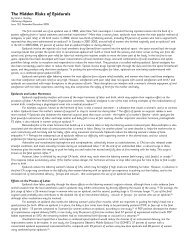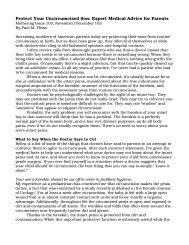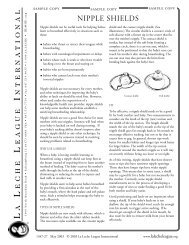Neonatal Ocular Prophylaxis Newborn Eye Ointment Is it necessary ...
Neonatal Ocular Prophylaxis Newborn Eye Ointment Is it necessary ...
Neonatal Ocular Prophylaxis Newborn Eye Ointment Is it necessary ...
You also want an ePaper? Increase the reach of your titles
YUMPU automatically turns print PDFs into web optimized ePapers that Google loves.
<strong>Neonatal</strong> <strong>Ocular</strong> <strong>Prophylaxis</strong><strong>Newborn</strong> <strong>Eye</strong> <strong>Ointment</strong><strong>Is</strong> <strong>it</strong> <strong>necessary</strong> and effective?According to medical studies, no. Below you will find studies which prove that the eye ointmentroutinely applied to newborns does not significantly alter eye infections as opposed to no ointment of anykind. Also, there is evidence that the bacteria which cause these infections are not passed to the infant inthe birth canal, but after birth. Also, <strong>it</strong> has been found that a significant number of infants develop aninfection even though they HAVE received the ointment. Read for yourself.Bell TA, Grayston JT, Krohn MA, Kronmal RA. Randomized trial of silver n<strong>it</strong>rate, erythromycin, and no eyeprophylaxis for the prevention of conjunctiv<strong>it</strong>is among newborns not at risk for gonococcal ophthalm<strong>it</strong>is.Pediatrics 1993 Dec;92(6):755-60. <strong>Eye</strong> <strong>Prophylaxis</strong> Study Group. Department of Biostatistics, Univers<strong>it</strong>yof Washington, Seattle 98195. OBJECTIVE. To compare the efficacy of commonly used forms of eyeprophylaxis for newborns w<strong>it</strong>h no prophylaxis in the prevention of nongonococcal conjunctiv<strong>it</strong>is. The resultssuggest that parental choice of a prophylaxis agent including no prophylaxis is reasonable for womenreceiving prenatal care and who are screened for sexually transm<strong>it</strong>ted diseases during pregnancy.Chen JY. <strong>Prophylaxis</strong> of ophthalmia neonatorum: comparison of silver n<strong>it</strong>rate, tetracycline, erythromycinand no prophylaxis. Pediatr Infect Dis J 1992 Dec;11(12):1026-30.The incidence rates of neonatal chlamydial conjunctiv<strong>it</strong>is in the tetracycline, erythromycin, silvern<strong>it</strong>rate, no prophylaxis and erythromycin twice groups were 1.3, 1.5, 1.7, 1.6 and 1.4%, respectively. Weconclude that neonatal ocular prophylaxis w<strong>it</strong>h erythromycin (one or two doses) or tetracycline or silvern<strong>it</strong>rate does not significantly reduce the incidence of neonatal chlamydial conjunctiv<strong>it</strong>is compared w<strong>it</strong>h thatin those given no prophylaxis.Krohn MA, Hillier SL, Bell TA, Kronmal RA, Grayston JT. The bacterial etiology of conjunctiv<strong>it</strong>is in earlyinfancy. 5: Am J Epidemiol 1993 Sep 1;138(5):326-32.The findings concerning the species of bacteria most often associated w<strong>it</strong>h conjunctiv<strong>it</strong>is, as well asthe finding that method of delivery is unimportant, suggest that bacteria were transm<strong>it</strong>ted to the infants'eyes after birth and not from the birth canal.Black-Payne C, Bocchini JA Jr, Cedotal C. Failure of erythromycin ointment for postnatal ocular prophylaxisof chlamydial conjunctiv<strong>it</strong>is. 14: Pediatr Infect Dis J 1989 Aug;8(8):491-5.The conclusion was that a substantial percentage of infants exposed to Chlamydia developchlamydial conjunctiv<strong>it</strong>is desp<strong>it</strong>e receiving erythromycin ocular prophylaxis.I feel inclined to ask, if the infants are contracting the bacteria after birth and not in the birth canal,where is <strong>it</strong> coming from? In the hosp<strong>it</strong>al, bacteria is rampant, and even the chemical sterilizing agents usedto clean hosp<strong>it</strong>als have been shown to be ineffective in totally wiping out bacteria. It is hard for me tobelieve that <strong>it</strong> was introduced to the infants by the mothers after birth; the baby makes <strong>it</strong> through the birthcanal, w<strong>it</strong>h the mother's bodily fluids smeared all over <strong>it</strong>, and still comes out w<strong>it</strong>hout an infection, only to beintroduced to <strong>it</strong> from normal handling by the mother? I don't think so. I can only conclude <strong>it</strong> was introducedby the handling of hosp<strong>it</strong>al personnel.Another good reason for home birth, where your baby is already immune to the germs in theenvironment <strong>it</strong> is born into.Copyright 2001 Judie C. Rall and The Center for Unhindered Livinghttp://www.unhinderedliving.com/eyeointment.html
From http://gentlebirth.org/archives/eyeointm.html - Midwives and moms post their thoughts.Historical Perspective on <strong>Eye</strong> InfectionsI couldn't find numbers, but all authors agree that <strong>it</strong> used to be a primary cause of blindness. From 1965Universal Home Doctor:“gonorrhea It has been calculated that this disease accounted for one third to one half of all thepersons in blind asylums, so destructive of sight <strong>it</strong> is; but now that <strong>it</strong> is more vigorously dealt w<strong>it</strong>h and isnotifiable by doctors and midwives <strong>it</strong>s incidence has been kept down. [This was wr<strong>it</strong>ten in 1930.]”It was a very obvious infection and very difficult to treat.Delee's Obstetrics for Nurses (1937 ed<strong>it</strong>ion):“[gonorrhea] quickly sets up a violent inflammation of the conjunctiva. at first the lids grow red ,then there is a thin, irr<strong>it</strong>ating discharge, w<strong>it</strong>h yellowish flakes. After a few hours this becomes purulent andth lids become so swollen that the eyes are closed. Unless active and constant treatment is inst<strong>it</strong>uted, theinflammation gains headway, the cornea may ulcerate, leaving ugly scars which shut out the light, or thelens may escape and the whole eye be destroyed. A large part of the blindness in the world is caused bythis dreadful affliction, and <strong>it</strong> is primarily venereal in origin. pg 496-497”There is a HORRIBLE picture of a baby w<strong>it</strong>h the disease-eyes-really the entire upper face-swollenand distorted, red, oozing yellow pus. Believe me, <strong>it</strong> looks nothing like any conjunctiv<strong>it</strong>is I have ever seen. Ican't imagine anyone not noticing <strong>it</strong>, or ignoring <strong>it</strong>.The treatment in those days consisted of frequent "irrigations" w<strong>it</strong>h warm saline and/or applicationsof ice packs made of sterile saline poured over sterile ice cubes. The nurse applies these "ice-cold pledgets(cotton balls) on the lids, changing them every minute, and throwing the waste into a paper bag at theside. The order may be to keep up the application of cold for twenty-four hours and not to interrupt <strong>it</strong>while the child is nursing." And days and weeks of constant care were required to fight the infection,prevent eye damage and attempt to prevent <strong>it</strong>s spread to the family and caregivers.It's really very sad to see the pictures in this book.Contrast this treatment w<strong>it</strong>h a later book- Handbook of Pediatrics (1975: post-penicillin)- "Theprognosis w<strong>it</strong>h treatment is generally very good, and cure should result w<strong>it</strong>hin two to four days."I frequently send up a prayer of thanks for the discovery of antibiotics.The whole notion of gonorrhea causing blindness in this day and age is ridiculous. GC in anewborns eyes is supposed to cause an outrageously awful infection. They go blind from abscesses andulcerations - not a silent destructive subclinical infection. Nobody would miss <strong>it</strong>. It's like other pathologicalconjunctiv<strong>it</strong>is's: if the eye is extremely purulent, swollen, and red they need antibiotics. Even if the babedeveloped the beginning of a GC pos<strong>it</strong>ive eye infection the treatment would still prevent blindness.Nobody would be home w<strong>it</strong>h a lavender and saline compresses, mistaking <strong>it</strong> for a plugged duct. I saw afilm once of the treatment before antibiotics, when all they could do was irrigate the eyes w<strong>it</strong>h who knowswhat. I was impressed.Though the erythromycin doesn't burn, <strong>it</strong> is an antibiotic which I suspect will enter the bloodstreamthrough the eye, thus <strong>it</strong> is my assumption that the potential for candida diaper rash, thrush, digestiveproblems and antibiotic resistance are raised when eye prophylaxis is administered.I don't know about those problems, but I have noticed that we tend to see more sticky eyes inbabies who have had the erythromycin. My thought on that one is that there is likely some kind of localirr<strong>it</strong>ant reaction to the ointment, which causes swelling of the tear ducts and blockage. W<strong>it</strong>h improperdrainage, a breeding s<strong>it</strong>e for bacteria develops and, voila, a sticky eye (almost always just one, we'venoticed).Would be good to see a clinical trial on this. I think mandatory eye prophylaxis is a stupid notion,frankly. For all the reasons c<strong>it</strong>ed, thus far.











